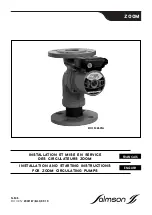
20
www.hotwater .com
100304526_2000545240 _Rev. 01
TEMPERATURE-PRESSURE RELIEF VALVE
•
Temperature-pressure relief
valve must comply with ANSI
Z21.22-CSA4.4 and ASME
code.
•
Properly sized temperature-
pressure relief valve must be
installed in opening provided.
•
Do not plug, block, or cap the
discharge line.
•
Failure to follow this warning
can result in excessive tank
pressure, serious injury or
death.
Explosion Hazard
WARNING
This water heater is provided with a properly rated/sized
and certified combination Temperature-Pressure Relief
Valve (T&P valve) by the manufacturer. The valve is
certified by a nationally recognized testing laboratory
that maintains periodic inspection of production of listed
equipment of materials as meeting the requirements for
Relief Valves for Hot Water Supply Systems, ANSI
Z21.22-CSA 4.4
, and the code requirements of ASME.
If replaced, the new T&P valve must meet the requirements
of local codes, but not less than a combination temperature-
pressure relief valve rated/sized and certified as indicated
in the above paragraph. The new valve must be marked
with a maximum set pressure not to exceed the marked
hydrostatic working pressure of the water heater (150 psi)
and a discharge capacity not less than the water heater
BTU/hr input rate as shown on the water heater’s model
rating plate.
For safe operation of the water heater, the temperature-
pressure relief valve must not be removed from its
designated opening nor plugged. The T&P valve must be
installed directly into the fitting of the water heater designed
for the relief valve. Install discharge piping so that any
discharge will exit the pipe within 6” above an adequate
floor drain. Be certain that no contact is made with any
live electrical part.
The discharge opening must not be blocked or reduced
in size under any circumstances. Excessive length (over
30’ ), or use of more than four elbows can cause restriction
and reduce the discharge capacity of the valve.
No valve or other obstruction is to be placed between the
T&P valve and the tank. Do not connect discharge piping
directly to the drain unless a maximum of 6” air gap is
provided. To prevent bodily injury, hazard to life, or property
damage, the relief valve must be allowed to discharge
water in adequate quantities should circumstances
demand. If the discharge pipe is not connected to a drain
or other suitable means, the water flow may cause property
damage.
•
Temperature-pressure relief valve discharge pipe
must terminate at an adequate drain.
Water Damage Hazard
CAUTION
T&P Valve Discharge Pipe Requirements:
•
Must not be smaller than the pipe size of the relief
valve or have any reducing coupling installed in the
discharge line.
•
Must not be capped, blocked, plugged or contain
any valve between the relief valve and the end of the
discharge line.
•
Must terminate a maximum of six inches above a floor
drain or external to the building. In cold climates, it is
recommended that the discharge pipe be terminated
at an adequate drain inside the building.
•
Must be capable of withstanding 250°F without
distortion.
•
Must be installed to allow complete drainage of both
the valve and discharge line.
•
Burn hazard.
•
Hot water discharge.
•
Keep clear of
temperature-pressure
relief valve discharge.
BURN
HOT
HOT
DANGER
It is recommended to manually operate the T&P valve at
least once a year. Caution should be taken to ensure (1) no
one is in front of or around the outlet of the discharge line,
and (2) the water manually discharged will not cause any
bodily injury or property damage because the water may
be extremely hot. If after manually operating the valve, it
fails to completely reset and continues to release water,
immediately close the cold-water inlet to the water heater,
follow the draining instructions in this manual, and replace
the temperature-pressure relief valve with a properly rated/
sized new one.
















































